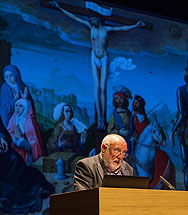“La <i>Crucifixión</i> de Juan de Flandes es una meditación sobre la muerte de Cristo y su capacidad redentora”
Professor Emeritus of Art History at the University of Zaragoza, Gonzalo M. Borrás, gave the fourth session of the series of conferences on El Prado.

On November 9, a new session of the lecture series "The Prado Museum: historical milestones of its collections" took place. "The Prado Museum: historical milestones of its collections", organized by the Fundación Amigos del Museo del Prado and the Faculty of Philosophy and Letters organized by the Friends of the Museo del Prado Foundation and the Faculty of Philosophy and Letters at the Museo Universidad de Navarra. On this occasion, Professor Emeritus of Art History at the University of Zaragoza, Gonzalo Borrás, gave a lecture entitled "The Crucifixion of Juan de Flandes given as a donation in 2005".
This work, 1.23 meters high and 1.69 meters wide, entered the Prado Museum in 2005, "under somewhat special circumstances, since the Ferrovial group gave it as a dation in payment of a tax debt. The piece was valued that year at 7,280,000 euros," said the professor. Throughout his presentation, and from the perspective of the teacher in the classroom, the expert wanted to "help to enjoy a work of art taking into account three elements: the commissioner, or the person who commissions the work, the artist, and the work itself".
This work was commissioned on December 19, 1509 by the Bishop of Palencia, Juan Rodríguez de Fonseca, "a man of noble family, of very refined taste, and lover of well done works and the third most important ecclesiastic of the Castile of Isabel and Fernando", to be part of the current main altarpiece of the Cathedral of Palencia. It was in 1527 when the altarpiece was mounted and 32 years later, in 1559, it was dismantled to move to the chapter house. Sold in 1944 to the Arburúa family by the Cathedral chapter, it was later acquired by the Ferrovial group.
As for the painter, Juan de Flandes, of whom "nothing is known before his arrival in Spain in 1496 to be court painter to Isabella the Catholic, but everything is very well documented from that year until 1504, the year of the queen's death, Professor Borrás pointed out as an interesting fact "how a painter with training as a miniaturist and portraitist, once Isabel the Catholic died, moved to Salamanca (1505-1509) and then to Palencia and moved from small format to large format, knowing how to adapt to the needs and conditions that this entailed".
The work, a meditationFinally, the professor analyzed the work itself from the technical, aesthetic, formal and compositional point of view, establishing connections with the cultural context of the time and, especially, with the theatrical representations that staged the Passion and Death of the Lord. This work "of symbolic naturalism" was conceived as a triptych, in which, in addition to the Crucifixion, which would occupy the central part, Jesus was shown with the Cross on his back, and the moment of his Burial. "This masterpiece by Juan de Flandes is a meditation, in it time stops to meditate, since it captures the moment in which Christ has expired. It shows the redemptive capacity of his death," he concluded.
